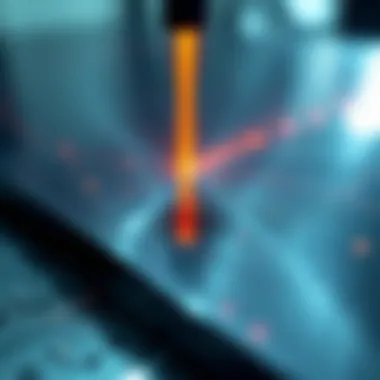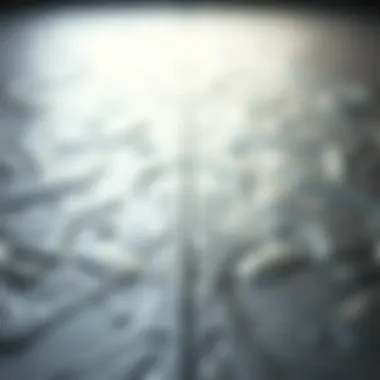Exploring Plasma Surface Modification Techniques


Intro
In the evolving landscape of material science, plasma surface modification stands out as a transformative technique. This method refrains from altering the core properties of materials while enhancing surface characteristics in significant ways. Essentially, it's all about making surfaces smarter, tougher, and more suitable for varied applications. With industries from electronics to biomedical science on board, understanding this field becomes crucial for anyone looking to be at the cutting edge of technology.
The phrase "surface modification" might sound straightforward, but dive a little deeper, and you’ll find a whole universe of processes and applications waiting to be explored. From plasma etching which literally carves surfaces at the molecular level, to deposition techniques that offer advanced coating solutions, the potential is vast. As we peel back the layers of this subject, we'll uncover a rich tapestry of techniques that not only shape materials but also the very future of technology itself.
By grasping the fundamentals, methodologies, and applications associated with plasma surface modification, professionals and enthusiasts alike can better understand the implications of this innovative approach. Keep reading as we embark on this journey to explore the multifaceted world of plasma technology.
Prelude to Plasma Surface Modification
Plasma surface modification sits at the intersection of innovation and practical application, serving as a vital tool in modern material science and engineering. This technique not only alters surfaces but also enhances their properties without impacting the overall integrity of the material. As industries strive for higher performance and durability, understanding the ins and outs of plasma technology becomes crucial.
Defining Plasma
Plasma, often referred to as the fourth state of matter, is an ionized gas where a significant portion of the particles are charged. It consists of ions, electrons, and neutral atoms, which come together to create a unique environment. This state can be achieved under certain conditions, typically involving high energy input that excites the gases to such a degree that electrons are stripped from atoms, resulting in a soup of charged particles.
Some may think of plasma as a scientific concept confined to the realms of physics or astronomy, but it has far-reaching applications across multiple domains. In everyday terms, one could regard plasma as the strange cousin in the family of matter—less tangible than solids, liquids, or gases but undoubtedly essential, especially in fields like electronics, medicine, and materials science.
Historical Context of Plasma Technology
Looking back, the journey of plasma technology is intertwined with advancements in science and technology. The concept of plasma was first introduced by Irving Langmuir in the 1920s, laying the foundation for what we understand today. Initially, its applications were largely theoretical, residing in the realm of physics labs, where scientists studied the behavior of ionized gases.
However, by the mid-20th century, the tide began to turn. The advent of technologies like the cathode ray tube (CRT) in televisions and computers showcased plasma’s capabilities. Fast forward to recent decades, 'plasma' has become synonymous with high-tech applications, from semiconductor manufacturing to the development of biomedical devices.
For instance, research into the noble gases used in plasma processes burgeoned after the 1970s, with the introduction of tools like plasma etchers revolutionizing the semiconductor industry. Today, plasma's capacity to modify surfaces is invaluable in producing materials with tailored properties, aiding industries from textiles to aerospace.
In summary, the historical progress of plasma technology reveals a fascinating evolution, transforming scientific curiosity into a cornerstone of modern manufacturing and innovation.
Mechanism of Plasma Interaction with Surfaces
Understanding the mechanism of plasma interaction with surfaces is crucial for grasping how plasma surface modification enhances material properties. This process is at the heart of many technological applications, as it fundamentally alters the surface characteristics of materials without affecting their bulk properties. The significance of this mechanism lies in its ability to facilitate diverse interactions, from altering adhesion properties to enhancing chemical reactivity.
Ionization Process in Plasma
In a plasma state, gaseous substances undergo ionization, a process where atoms or molecules lose or gain electrons. This transforms them into charged particles—ions and electrons—that interact with surfaces. The ionization typically happens when sufficient energy is provided, either through thermal means or via electromagnetic fields. Here’s a basic breakdown of the ionization process:
- Energy Input: The initial step involves imparting energy, often through an electric field, which excites atoms and causes them to ionize.
- Creation of Charged Species: As electrons are knocked off, ions become positively charged, while freed electrons accumulate.
- Sustaining Plasma: A significant factor here is maintaining the balance of positive ions and electrons to keep the plasma stable.
The ionization process creates a mix of reactive particles that actively participate in surface modification. This active layer introduces a variety of new functionalities, making materials more suitable for specific applications.
Surface Reactions and Modifications
Once the plasma interacts with a material's surface, a series of surface reactions can initiate. These reactions are often dictated by the type of plasma gas utilized—such as argon, oxygen, or nitrogen—and the energy level of the ions.
- Physical Modifications: The bombardment of ions can lead to physical alterations on the surface such as etching, wherein unwanted materials are removed, thereby improving surface cleanliness and reactivity.
- Chemical Modifications: Beyond physical changes, plasma can facilitate chemical reactions that alter the surface chemistry. For instance, adding functional groups to a polymer surface enhances its bonding properties, making it more compatible with adhesives or coatings.
The types of reactions include:


- Activation of Surface Sites: Plasma treatment activates surface sites that can enhance adhesion properties, crucial for applications in electronics and packaging.
- Formation of Thin Films: The deposition of material layers via plasma can create protective coatings, leading to increased durability.
- Cleaning: The reactive species can clean surfaces by breaking down contaminants, resulting in improved performance in coatings or adhesives.
"The interactions between plasma and surfaces can bespoke changes that cater to specific application requirements, making this a preferred choice in advanced material science."
Understanding these mechanisms opens the door to innovative applications and potential advancements in various industries, from electronics to biotechnology, ensuring materials are optimized for their intended functions. This knowledge is paramount for researchers and professionals aiming to exploit plasma technology in real-world settings.
Types of Plasma Surface Modification Techniques
In the rapidly evolving world of materials science and engineering, the significance of plasma surface modification techniques cannot be overstated. These methods have not only revolutionized how we modify surface properties but have also played a vital role in enhancing the functionality and durability of materials across various industries. By understanding the intricacies behind these techniques, one gains insight into their potential applications and benefits.
The importance of exploring plasma surface modification techniques lies in their ability to improve the surface characteristics of materials without altering their bulk properties. This capability opens avenues for a wide range of applications—from electronics to biomedical devices—allowing for enhancements in adhesion, wettability, and even biocompatibility. It is particularly noteworthy that these methods can be tailored to specific needs in numerous sectors, making them highly versatile and valuable.
Plasma Etching Techniques
Plasma etching is one of the foremost plasma surface modification techniques, crucially utilized in the semiconductor industry. This process employs plasma to remove top layers from a material, facilitating highly precise patterning that’s essential for chips and circuits. Among the various forms of plasma etching, reactive ion etching (RIE) stands out for its consistent and controllable nature.
The convenience of plasma etching is that it allows for a high degree of customization. Different gases can be utilized depending on the material being etched. For instance, using fluorine-based gases like SF6 is common for etching silicon wafers, while oxygen can be beneficial for certain organic materials. The selectivity of these techniques—where specific materials can be etched away while preserving others—makes plasma etching a preferred choice in complex manufacturing scenarios.
- Bolstered precision: Plasma etching techniques can yield dimensions down to the nanometer scale.
- Wide compatibility: Different materials can be processed with specially chosen gases.
- Reduced waste: The controlled etching minimizes unnecessary removal of material.
The diverse nature of plasma etching techniques underscores their essential role in developing cutting-edge electronic devices.
Plasma Deposition Methods
Another crucial aspect of plasma surface modification is plasma deposition, where materials are deposited onto a substrate using plasma. This technique is particularly important in creating thin films that enhance surface properties. Two primary methods are often highlighted: chemical vapor deposition (CVD) and physical vapor deposition (PVD).
- CVD: In this method, gaseous reactants form a solid material on the substrate. For example, silicon-based thin films are commonly produced this way, which are crucial for fabricating electronic components.
- PVD: This method involves the physical transfer of material from a target to a substrate, usually via sputtering or evaporation techniques. Coatings produced by PVD are known for their durability and strong adhesion.
The applications of plasma deposition techniques are vast. They include:
- Optical coatings for enhancing the performance and life span of lenses.
- Protective barriers against corrosion in various metal applications.
- Biocompatible layers for medical devices, ensuring compatibility with biological tissues.
The beauty of plasma deposition lies in its flexibility and the ability to control film thickness with remarkable precision, ensuring that the coatings meet the required specifications for their intended applications.
Plasma Treatment Approaches
Plasma treatment approaches aim at altering the surface properties of materials for improved performance. Unlike etching or deposition, these methods focus on modifying the surface in a way that increases adhesion, wettability, or other desirable attributes without significantly adding material.
One popular method in plasma treatment is plasma cleaning, which removes contaminants and enhances surface energy. This is particularly crucial in scenarios where strong adhesive bonds are necessary. For example, surfaces subjected to plasma cleaning before adhesive application often show considerably improved adhesion properties.
Another notable technique is plasma activation, which modifies the surface reactivity. In applications involving textiles, plasma activation can be employed to increase dye uptake or improve the bonding of coatings.
- Enhancement of adhesion properties in varied industries like automotive and construction.
- Reduction of contaminants before further processing in manufacturing.
- Improvement of wettability for better interactions with liquids, beneficial for coatings and inks.
In summary, plasma treatment approaches provide a simplistic yet powerful means of enhancing surface attributes, making them extremely useful in manufacturing practices.
Overall, the myriad plasma surface modification techniques discussed provide a clear framework for enhancing material performance across different sectors, reflecting the adaptability and utility of plasma technology in advancing the field of materials science.


Applications of Plasma Surface Modification
The realm of plasma surface modification has burgeoned into a crucial technique across various industries today. This evolution springs from the unique properties of plasma, which allow for fine-tuning of surface characteristics without altering the core of the material. By diving into specific applications, we can unearth the distinct benefits and considerations that plasma surface modification hoists into the spotlight.
Electronics and Semiconductors
In the fast-paced world of electronics, plasma surface modification showcases its prowess predominantly in the field of semiconductors. The manipulation of surfaces through techniques like plasma etching is instrumental in creating minute patterns on silicon wafers. This is where precision becomes pivotal. By employing different gases, manufacturers can achieve desired surface characteristics vital for device performance. The significance here is immense, as optimized surfaces lead to better electronic properties like conductivity and other critical functionalities necessary for integrated circuits. Not to mention, the clean and residue-free nature of plasma processes often trumps traditional methods.
"Plasma processing is a game-changer for electronics, providing unprecedented control over surface properties."
Biomedical Applications
Turning to the biomedical sector, plasma surface modification has emerged as a key contributor to advancing medical technology. Modifying surfaces of medical implants through plasma treatment not only enhances biocompatibility but also promotes better cell adhesion. This is particularly evident in materials like titanium, commonly used in orthopedic and dental applications. The roughened surface created by plasma etching can facilitate a stronger bond between the implant and biological tissue, leading to improved integration and longevity. As healthcare continues evolving, the role of plasma technologies in driving innovations for tissue engineering and drug delivery systems cannot be overstated.
Textile and Polymer Treatments
In the textile industry, plasma surface modification finds its place by enabling a diverse range of functionalities in fabrics. For instance, treatments can impart water repellency, stain resistance, or even anti-static properties to everyday garments. The ability to modify polymer surfaces extends beyond textiles, allowing coatings that enhance adhesion in paints or adhesives. Herein, curiosity meets practicality: how can we make textiles not only functional but also longer-lasting? Through plasma treatments, the answer lies in durable, high-performance materials that respond aptly to consumer needs while minimizing environmental impacts.
Coatings and Surface Protection
Another critical application of plasma surface modification is in the domain of coatings and surface protection. Plasma coating methods contribute to developing thin layers on substrates that enhance wear resistance, scratch resistance, and corrosion protection. This is particularly vital for industries dealing with harsh environments, such as aerospace and automotive. For instance, applying a plasma-enhanced chemical vapor deposition can significantly improve the longevity and performance of components exposed to extreme conditions.
- Durability: Plasma-based coatings stand the test of time under abrasive conditions.
- Versatility: The adaptability of plasma techniques allows for coatings on a myriad of materials, from metals to ceramics.
- Efficiency: These methods generally offer faster processing times and reduced waste compared to traditional coating techniques.
In essence, the applications of plasma surface modification are a testament to its versatility across multiple domains. The far-reaching implications of this technology hint at a future where enhancements in material properties could lead to unprecedented advancements in various fields. As we peel back the layers of plasma technology, we observe not only the potential benefits but also a platform for innovation that welcomes collaboration across industries.
Comparative Analysis of Plasma Techniques
The comparative analysis of plasma techniques is pivotal in understanding their unique roles and functionalities in material modification. Unlike more straightforward methods like mechanical cutting or chemical treatments, plasma surface modification offers flexibility and precision, where minor adjustments can lead to significant enhancements in material properties. Thus, scrutinizing these methods' advantages and shortcomings is not just academic—it shapes the future applications across various industries.
Advantages of Plasma Modification
Plasma modification shines due to its ability to tailor specific surface attributes without altering the core material characteristics. Here are some standout advantages:
- Enhanced Surface Properties: Plasma processes modify surface energy, improve adhesion, and increase wettability, which can be crucial in industries like biotechnology and electronics.
- Environmental Impact: Compared to chemical-based approaches, plasma treatment often utilizes fewer harmful substances, leading to lower environmental footprints and safer work environments.
- Thermal Control: The non-thermal nature of plasma techniques allows for modifications at lower temperatures, preventing thermal degradation of sensitive substrates.
"The adaptability of plasma processing techniques enables innovation that reaches beyond traditional material limitations."
These attributes make plasma surface modification a go-to choice for researchers and manufacturers seeking to enhance product performance without compromising the material integrity.
Limitations and Challenges
However, despite its advantages, plasma surface modification is not without its hurdles. Some of the challenges that researchers often face include:
- Equipment Complexity: The setup for plasma treatments can be intricate and costly, limiting accessibility for smaller-scale operations or research labs.
- Process Control: Achieving consistent and reproducible results can be tricky, as plasma conditions can vary based on environmental factors and machine calibration.
- Material Compatibility: Not all materials respond equally to plasma processes; thus, testing and optimization for specific applications can require extensive trials and could lead to frustrated efforts.
These limitations underline the necessity for continued research and development to enhance plasma technology efficiency and broader applicability.


Efficiency and Cost-Effectiveness
When discussing efficiency and cost-effectiveness, it becomes important to see how plasma surface modification aligns with economic considerations and resource management. The trade-off can be quite illuminating:
- Initial Investment vs Long-Term Savings: While initial costs for plasma systems can be high, the durability and enhanced performance of treated materials often lead to lower maintenance and replacement costs over time.
- Scalability: Some plasma techniques can be scaled for large production runs, enabling cost reductions compared to traditional methods, but this scalability is not universal across all types of plasma processing techniques.
- Energy Consumption: Plasma generation can be energy-intensive; therefore, optimizing processes for energy efficiency is a vital area of ongoing research that could lead to significant cost savings.
Ultimately, balancing efficiency with cost considerations is crucial for industries looking to implement plasma surface modification in their operations while maintaining competitive edges in their respective markets.
Future Directions in Plasma Surface Modification
The ongoing evolution of plasma surface modification holds significant promise for a variety of industries, influencing both the efficiency of processes and the performance of materials. As we delve into future directions in this field, it’s crucial to underscore the need for integration with emerging technologies and the refinement of existing processes. The expanding capabilities of plasma technology can elevate its relevance beyond traditional applications, addressing new challenges faced by industries today.
Emerging Technologies
In recent years, several emerging technologies have begun to reshape the landscape of plasma surface modification. One noteworthy avenue is the development of low-pressure plasma techniques, allowing for finer control over surface modifications. This precision could result in tailored surfaces that enhance adhesion properties, crucial in fields like biomedical engineering and microelectronics.
Moreover, the combination of plasma techniques with machine learning presents an exciting opportunity. By utilizing predictive algorithms, scientists can analyze large datasets to optimize plasma parameters, improving both efficiency and outcome predictability. This synergy between computational models and experimental techniques can lead to breakthroughs in how surfaces are modified at a molecular level.
Another trend is the rise of plasma-induced nanostructuring, which enables the design of materials at the nanoscale. Such structures can significantly alter a material's physical properties—be it mechanical strength or thermal stability—making them invaluable across a range of industries including aerospace and automotive.
Key Points on Emerging Technologies:
- Low-pressure plasma for enhanced control
- Machine learning for optimization
- Plasma-induced nanostructuring for advanced materials
Integration with Other Processes
The future of plasma surface modification lies not only in innovation within its own domain but also in its integration with other manufacturing processes. Combining plasma treatment with additive manufacturing, for instance, can lead to improved bonding between layers, which is particularly beneficial in 3D printing. This integration helps overcome common issues like delamination, ultimately enhancing the durability of printed components.
The coupling of plasma processes with chemical vapor deposition (CVD) and physical vapor deposition (PVD) techniques is another promising pathway. By applying plasma modification before or during deposition, it’s possible to improve coating adhesion and uniformity, maximizing the effectiveness of protective layers.
Furthermore, integrating plasma surface modification into large-scale manufacturing—such as in assembly lines for automotive or electronics—could lead to significant reductions in production costs while enhancing overall product quality. This not only positions plasma technology as a key player in future manufacturing but also highlights its potential for large-scale application.
Considerations for Integration:
- Enhancing bonding in 3D printing
- Improving coating processes with plasma
- Cost reductions in large-scale applications
"The synergy between plasma technology and other processes could create unprecedented manufacturing solutions, driving industries towards greater innovation."
Epilogue
In summarizing the multifaceted realm of plasma surface modification, it becomes clear that this technology holds immense significance across various industries. One of the primary advantages of plasma surface modification is its ability to tailor surface properties without affecting the bulk characteristics of materials. This unique feature allows for enhanced performance in numerous applications, resulting in improved functionalities in areas such as electronics, biomedicine, and textiles.
The introduction of plasma techniques has led to notable advancements, particularly in the development of stronger and more resilient materials. For instance, in semiconductor manufacturing, the use of plasma etching has revolutionized the fabrication process, enabling intricate patterns and configurations that were once deemed impossible.
Furthermore, the versatility of plasma technology cannot be overstated. It offers a range of modification methods such as etching, deposition, and treatment that cater to diverse requirements. These varying techniques allow designers and engineers to select the most suitable approach for their specific applications, which, in turn, paves the way for innovation.
However, alongside the benefits, the obstacles that come with plasma surface modification must also be acknowledged. Factors such as equipment costs, scalability, and the specific expertise required to operate plasma systems present challenges that need addressing for broader adoption in conventional markets.
As we cast our gaze toward the future, it’s clear that emerging technologies will only further amplify the capabilities of plasma modification. The integration of plasma processes with other technologies can lead to synergistic effects, enhancing both efficiency and product quality. Looking ahead, improvements in plasma efficiency and the reduction of operational costs will likely drive more widespread use in various sectors.
"The true test of a technology is whether it can endure and adapt, and plasma surface modification has shown it can do just that."
For readers keen on exploring more, resources are plentiful. Consulting sites like Wikipedia and Britannica can offer deeper insights into the principles behind plasma technology. Additionally, the platforms of Reddit and Facebook host discussions among practitioners and enthusiasts that could further broaden understanding.
With its profound implications on advancement and efficiencies in diverse fields, understanding plasma surface modification is not only advantageous, it is essential.















